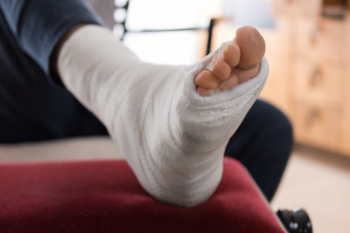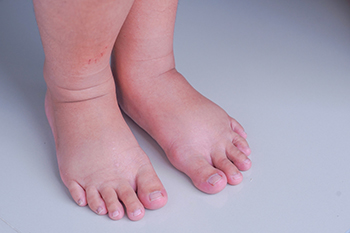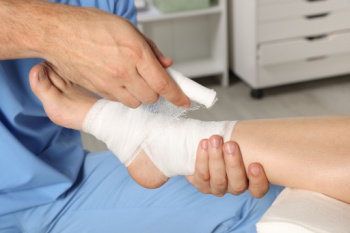Connect With Us
Blog
Items filtered by date: July 2025
Recognizing Risk Factors for Achilles Tendon Problems Early

The Achilles tendon plays a vital role in walking, running, and standing on your toes. When it becomes strained or inflamed, even simple movements can become painful. Identifying risk factors early can help prevent long-term problems. Tight calf muscles, poor ankle flexibility, and a sudden increase in physical activity are common contributors. Wearing unsupportive shoes or changing exercise routines without preparation can also place added stress on the tendon. Age may also be a factor, as tendons naturally lose flexibility over time. People who have flat feet or high arches may place uneven pressure on the Achilles tendon, increasing the risk of injury. Past ankle injuries and certain medications can also weaken the tendon. If you are experiencing tightness, swelling, or pain near the back of your heel, it is suggested you visit a podiatrist to assess your risk, treat various foot conditions, and discuss steps to protect your Achilles tendon.
Achilles tendon injuries need immediate attention to avoid future complications. If you have any concerns, contact Melissa C. Verde, DPM of Florida. Our doctor can provide the care you need to keep you pain-free and on your feet.
What Is the Achilles Tendon?
The Achilles tendon is a tendon that connects the lower leg muscles and calf to the heel of the foot. It is the strongest tendon in the human body and is essential for making movement possible. Because this tendon is such an integral part of the body, any injuries to it can create immense difficulties and should immediately be presented to a doctor.
What Are the Symptoms of an Achilles Tendon Injury?
There are various types of injuries that can affect the Achilles tendon. The two most common injuries are Achilles tendinitis and ruptures of the tendon.
Achilles Tendinitis Symptoms
- Inflammation
- Dull to severe pain
- Increased blood flow to the tendon
- Thickening of the tendon
Rupture Symptoms
- Extreme pain and swelling in the foot
- Total immobility
Treatment and Prevention
Achilles tendon injuries are diagnosed by a thorough physical evaluation, which can include an MRI. Treatment involves rest, physical therapy, and in some cases, surgery. However, various preventative measures can be taken to avoid these injuries, such as:
- Thorough stretching of the tendon before and after exercise
- Strengthening exercises like calf raises, squats, leg curls, leg extensions, leg raises, lunges, and leg presses
If you have any questions please feel free to contact our office located in Longwood, FL . We offer the newest diagnostic tools and technology to treat your foot and ankle needs.
Recognizing and Treating a Fractured Foot Bone

A broken metatarsal refers to a fracture in one of the long bones in the middle of the foot. While some people may still walk on a broken metatarsal, doing so can worsen the injury and delay healing. Symptoms include pain, swelling, bruising, and difficulty bearing weight. Causes include direct trauma, falls, overuse during sports, and high-impact activities. Among the risk factors are osteoporosis, improper footwear, and intense physical activity. A podiatrist can diagnose the fracture through examination and imaging, then recommend a personalized treatment plan. This may include immobilization, rest, or, in some cases, surgery. If you suspect a broken metatarsal, do not ignore the pain. It is suggested that you seek expert podiatric care to ensure a full and safe recovery.
A broken foot requires immediate medical attention and treatment. If you need your feet checked, contact Melissa C. Verde, DPM from Florida. Our doctor can provide the care you need to keep you pain-free and on your feet.
Broken Foot Causes, Symptoms, and Treatment
A broken foot is caused by one of the bones in the foot typically breaking when bended, crushed, or stretched beyond its natural capabilities. Usually the location of the fracture indicates how the break occurred, whether it was through an object, fall, or any other type of injury.
Common Symptoms of Broken Feet:
- Bruising
- Pain
- Redness
- Swelling
- Blue in color
- Numbness
- Cold
- Misshapen
- Cuts
- Deformities
Those that suspect they have a broken foot shoot seek urgent medical attention where a medical professional could diagnose the severity.
Treatment for broken bones varies depending on the cause, severity and location. Some will require the use of splints, casts or crutches while others could even involve surgery to repair the broken bones. Personal care includes the use of ice and keeping the foot stabilized and elevated.
If you have any questions, please feel free to contact our office located in Longwood, FL . We offer the newest diagnostic and treatment technologies for all your foot care needs.
What Swollen Feet in Late Pregnancy Can Mean

Swollen feet are common during late pregnancy and are often caused by edema, which is the buildup of fluid in the lower limbs due to increased pressure from the growing uterus. However, swelling can also signal more serious conditions. Preeclampsia may cause sudden or severe swelling along with high blood pressure. Peripartum cardiomyopathy, a rare form of heart failure, and deep vein thrombosis, a blood clot in the leg, are medical emergencies. A podiatrist can help monitor swelling, recommend supportive footwear, suggest exercises, and identify signs that need urgent care. If you notice unusual or painful foot swelling during your pregnancy, it is strongly suggested that you promptly visit a podiatrist for expert guidance and relief options.
Pregnant women with swollen feet can be treated with a variety of different methods that are readily available. For more information about other cures for swollen feet during pregnancy, consult with Melissa C. Verde, DPM from Florida. Our doctor will attend to all of your foot and ankle needs.
What Foot Problems Can Arise During Pregnancy?
One problem that can occur is overpronation, which occurs when the arch of the foot flattens and tends to roll inward. This can cause pain and discomfort in your heels while you’re walking or even just standing up, trying to support your baby.
Another problem is edema, or swelling in the extremities. This often affects the feet during pregnancy but tends to occur in the later stages.
How Can I Keep My Feet Healthy During Pregnancy?
- Wearing orthotics can provide extra support for the feet and help distribute weight evenly
- Minimize the amount of time spent walking barefoot
- Wear shoes with good arch support
- Wear shoes that allow for good circulation to the feet
- Elevate feet if you experience swelling
- Massage your feet
- Get regular, light exercise, such as walking, to promote blood circulation to the feet
If you have any questions, please feel free to contact our office located in Longwood, FL . We offer the newest diagnostic and treatment technologies for all your foot care needs.
Inspect Your Feet Regularly for Abnormalities if You're Diabetic
The Role of a Podiatrist When Foot Wounds Do Not Heal

Chronic foot wounds that do not heal often result from underlying conditions, such as diabetes, which affects circulation and nerve function in the feet. Poor blood flow limits oxygen and nutrients essential for healing, while neuropathy reduces pain awareness, leading to unnoticed injuries. Infections can develop easily in these cases and complicate the healing process. A podiatrist plays a key role in identifying the cause of non-healing wounds, managing infections, offloading pressure, and improving wound care. Regular foot checks and early intervention are critical in preventing complications like ulcers or limb loss. If you notice a wound on your foot that does not improve, it is suggested that you schedule a visit with a podiatrist for expert care and treatment guidance.
Wound care is an important part in dealing with diabetes. If you have diabetes and a foot wound or would like more information about wound care for diabetics, consult with Melissa C. Verde, DPM from Florida. Our doctor will assess your condition and provide you with quality foot and ankle treatment.
What Is Wound Care?
Wound care is the practice of taking proper care of a wound. This can range from the smallest to the largest of wounds. While everyone can benefit from proper wound care, it is much more important for diabetics. Diabetics often suffer from poor blood circulation which causes wounds to heal much slower than they would in a non-diabetic.
What Is the Importance of Wound Care?
While it may not seem apparent with small ulcers on the foot, for diabetics, any size ulcer can become infected. Diabetics often also suffer from neuropathy, or nerve loss. This means they might not even feel when they have an ulcer on their foot. If the wound becomes severely infected, amputation may be necessary. Therefore, it is of the upmost importance to properly care for any and all foot wounds.
How to Care for Wounds
The best way to care for foot wounds is to prevent them. For diabetics, this means daily inspections of the feet for any signs of abnormalities or ulcers. It is also recommended to see a podiatrist several times a year for a foot inspection. If you do have an ulcer, run the wound under water to clear dirt from the wound; then apply antibiotic ointment to the wound and cover with a bandage. Bandages should be changed daily and keeping pressure off the wound is smart. It is advised to see a podiatrist, who can keep an eye on it.
If you have any questions please contact our office located in Longwood, FL . We offer the newest diagnostic and treatment technologies for all your foot and ankle needs.
Matching the Shoe With the Sport

Wearing shoes specific to the sport you are playing can help avoid foot, toe, or ankle injuries. Sports shoes are designed to combine cushioning, flexibility, fit, and traction suited to each sport’s demands. For instance, court shoes for tennis or pickleball include rounded midsoles, and firm outward ridges along the shoe edge that improve side‑to‑side stability. Their midfoot support and herringbone-pattern outsoles help to grip hard court surfaces during pivots. In contrast, running shoes are designed for forward motion with vertical edges and soft midsoles. This shoe would increase the risk of lateral ankle sprains and Achilles tendon injuries when worn in court sports. Basketball shoes vary from low-top styles that enhance speed and ankle muscle activation, to high-top versions that offer extra protection during rebounds. Traction patterns and midfoot reinforcements under the arch help to limit twisting during quick cuts. Cleats for soccer, football, and lacrosse use strategic stud placements and carbon-fiber outsoles for grip in multidirectional movement. Additionally, golf shoes feature spikes or hybrid soles and plates to steady the stance through swings. A podiatrist can evaluate your foot structure, sport requirements, and shoe features to recommend proper footwear. If you are experiencing foot pain after sports activity, it is suggested that you schedule an appointment with a podiatrist for advice and relief tips.
It is important to find shoes that fit you properly in order to avoid a variety of different foot problems. For more information about treatment, contact Melissa C. Verde, DPM from Florida. Our doctor will treat your foot and ankle needs.
Proper Shoe Fitting
Shoes have many different functions. They cushion our body weight, protect our feet, and allow us to safely play sports. You should always make sure that the shoes you wear fit you properly in order to avoid injuries and deformities such as: bunions, corns, calluses, hammertoes, plantar fasciitis, stress fractures, and more. It is important to note that although a certain pair of shoes might be a great fit for someone else, that doesn’t mean they will be a great fit for you. This is why you should always try on shoes before buying them to make sure they are worth the investment. Typically, shoes need to be replaced ever six months to one year of regular use.
Tips for Proper Shoe Fitting
- Select a shoe that is shaped like your foot
- Don’t buy shoes that fit too tight, expecting them to stretch to fit
- Make sure there is enough space (3/8” to ½”) for your longest toe at the end of each shoe when you are standing up
- Walk in the shoes to make sure they fit and feel right
- Don’t select shoes by the size marked inside the shoe, but by how the shoe fits your foot
The shoes you buy should always feel as good as they look. Shoes that fit properly will last longer, feel better, and improve your way of life each day.
If you have any questions please contact our office located in Longwood, FL . We offer the newest diagnostic and treatment technologies for all your foot and ankle needs.

